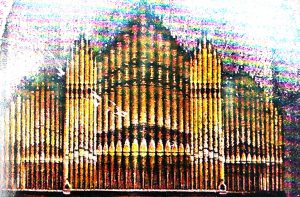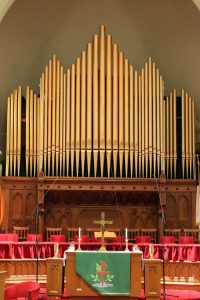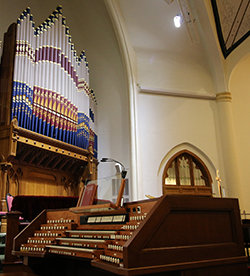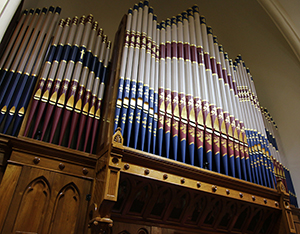Wabash is one of central Indiana’s most beautiful and successful small cities. Once a canal town, and later a railroad town, Wabash is situated on tall hills skirting the Wabash River.
First United Methodist Church is one of the oldest religious institutions in Wabash. The present building was constructed in 1900, twenty years after Wabash became the first electricprally-lighted city in the world. It is a town that appreciates its history and its culture. The two largest employers in Wabash, the Ford Meter Box Company, and Honeywell Corp., are both generous contributors to efforts to renew and promote the town. During the last 20 years, many landmarks have been restored or improved. Wabash is definitely worth a visit!

The original pipe organ at First Church was built in 1890 by the distinguished Detroit firm, Farrand and Votey. The organ consisted of seventeen ranks – 893 pipes, and boasted a magnificent pipe facade with a lower case built of solid American black walnut. In true late nineteenth-century style, the pipes were brightly stenciled and decorated. In about 1900, the Methodists built a new building across the street. They moved their pipe organ, and installed it in the new sanctuary.
Over the years, the old organ went through the usual revisions for an organ of its type. An electric blower was installed in 1918. The tracker action was electrified electrified in 1955, at which time a 3-manual console was installed in anticipation of an expansion of the instrument. That expansion happened in 1966. During that expansion, the builder contrived to install 32 ranks in the same space occupied by the original seventeen. The organ was difficult to service, and some problems went unrepaired for decades because even minor repairs were so costly. When the trumpet stop in the Swell division developed problems, for instance, the solution was to simply cut the wire that activated the pipes.

Over the years, as decorating tastes changed, the brilliant facade was repainted repeatedly. Each time, damage was done to the fragile pipes, and each coat of paint added another layer of glop. Finally, by the 1966 project, the facade pipes were disconnected. Their mouths were clogged with heavy paint that had even run down inside the foot cones of the pipes. They were painted a dark gold color. (Note: There are no gold organ pipes in the real world.)
The project to build the new organ would be very complex. We felt that the active music program at First Church needed a very flexible, distinguished voice to support worship. To preserve as much of the organ’s history and of the congregation’s investment in the organ as possible, we carefully evaluated the pipes in existing organ. Some of these pipes were original, and appeared to be from the Farrand & Votey organ. Others were added later, including some pipes that had been added in 1966. None of the stops in the organ was particularly striking. There was a sameness in almost every combination the organist selected.
To increase the available space for pipes, we decided to incorporate a very complete antiphonal division. The antiphonal would be in the rear of the sanctuary high in the room. Because the new organ was to be part of an overall renovation of the church sanctuary, we were able to work with the architect to create this space.
The main organ in the front of the room would contain very complete Great and Swell divisions, as well as a small Choir. The latter division was designed to speak through panels in the lower facade where they would be clearly heard by the singers in the choir loft. For code reasons, moving the case to create more space behind it was not an option. David Reynolds designed a layout that could speak clearly into the room. Mechanical repairs to the organ can be conveniently accomplished. Most of the actions under the pipes can be reached with the removal of only eight screws.
Since the Choir division is necessarily limited in size, the antiphonal becomes very important in this organ. We designed an American Romantic division that contains a full ensemble, along with a wealth of coloristic Romantic stops, many built in the early twentieth century by the Estey Organ Company. Every pipe from the original organ and every vintage pipe was reconditioned to new condition. All the pipes in the organ, whether new or vintage, were carefully voiced and regulated, both to perfect their sound and to give the entire organ a natural blend of sound. The result is striking.
This is a “Covid” organ. Much of it was built in our shop before the pandemic struck. Dealing with church closures, vendor shut-downs, and transportation problems made completion tediously slow. Finally, though, the organ was completed. The last step was to install the refurbished case and facade.

The facade decoration was designed in conjunction with the church’s organ committee. After looking at several examples, the idea was adopted to recreate as much of the original decoration as possible, adjusting the colors to the current color palette of the room. We were able to discover the original design from the single photograph we had, and from shadows of the original figures that appeared on the pipes when the layers of paint were stripped off. Then, using a photograph of the case, we superimposed these patterns and colors with Photoshop, so the committee could visualize the result.
We transported the pipes to Oyster Pipeworks in eastern Ohio. Fred Oyster and his team are some of the best organ pipe makers and craftsmen in the world. They disassemble the pipes to strip the old paint out of them and to remove dents and tears. Then, they repainted them and trimmed them with 22k gold leaf. Reinstalled, they make a magnificent visual statement in the sanctuary.
Ken Cowan dedicated the new organ with a Christmas-themed concert in December 2021.
The following article previously appeared in our “News” section:
First United Methodist Church, Wabash, IN
Beautiful New Reynolds Organ Dedicated!

First United Methodist Church, Wabash, IN

December 12, 2021 was a beautiful early winter day in Wabash Indiana. On that afternoon, Ken Cowan, one of the world’s most popular and capable concert organists dedicated the new Reynolds Associates pipe organ at First United Methodist Church. This new three-manual organ boasts 47 ranks with a total of 2,666 pipes. The congregation selected Christmastime for the inaugural concert even though the new Fanfare Trumpet has yet to be installed due to Covid-related delays. (These pipes are nearly completed and should be installed by spring.)
Ken’s concert featured mostly Christmas music, beginning with David Conte’s Christmas Intrada, and ending with the Variations on “Adeste Fidelis” by Gaston Dethier. We recorded the concert in its entirety, so watch our YouTube page. We will post them as they are edited. In fact, the Dethier is being posted as I write.
First United Methodist Church in Wabash, IN in concert
on December 12, 2021.
The native walnut case of the organ has been carefully restored, and the facade pipes were redecorated in a style reminiscent of the original 1890 Farrand & Votey installation. The facade design was created by Thad Reynolds in cooperation with the church’s organ committee, and was executed by Audra Kinnard of Oyster Pipe Works. Much of the original design is used, with new colorations in red and blue with 24 carat gold leaf accents. The visual effect is stunningly beautiful.
Like most projects these days, the Wabash organ has had its share of frustrations (see the story below), but the result is a magnificent instrument that will be part of the congregation’s worship experience for decades to come. Soli Deo Gloria!